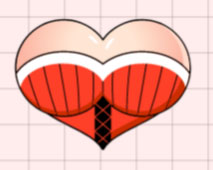Breast anatomy
The breast anatomy of males and females is slightly different. Female breasts have milk ducts and glandular tissue that aid breastfeeding. Male and female breast nipples have many nerves that enhance sexual arousal. All genders can get breast cancer. Women are more prone to benign (noncancerous) breast disease.
Breast anatomy
What are breasts?
Breasts are part of the female and male sexual anatomy. For females, breasts are both functional (for breastfeeding) and sexual (bringing pleasure). Male breasts don’t have a function. The visible parts of breast anatomy include the nipples and areolae.
What are breasts made of?
Several kinds of tissue form female breasts. Muscles connect breasts to ribs, but they aren’t part of the breast anatomy. The different types of breast tissue include:
Glandular: Also called lobules, glandular tissue produces milk.
Fatty: This tissue determines breast size.
Connective or fibrous: This tissue holds glandular and fatty breast tissue in place.
What parts make up breast anatomy?
There are many different parts to female breast anatomy, including:
Lobes: Each breast has between 15 to 20 lobes or sections. These lobes surround the nipple like spokes on a wheel.
Glandular tissue (lobules): These small sections of tissue found inside lobes have tiny bulblike glands at the end that produce milk.
Milk (mammary) ducts: These small tubes, or ducts, carry milk from glandular tissue (lobules) to nipples.
Nipples: The nipple is in the center of the areola. Each nipple has about nine milk ducts, as well as nerves.
Areolae: The areola is the circular dark-colored area of skin surrounding the nipple. Areolae have glands called Montgomery’s glands that secrete a lubricating oil. This oil protects the nipple and skin from chafing during breastfeeding.
Blood vessels: Blood vessels circulate blood throughout the breasts, chest and body.
Lymph vessels: Part of the lymphatic system, these vessels transport lymph, a fluid that helps your body’s immune system fight infection. Lymph vessels connect to lymph nodes, or glands, found under the armpits, in the chest and other places.
Nerves: Nipples have hundreds of nerve endings, which makes them extremely sensitive to touch and arousal.
Breast Anatomy
The breast anatomy of males and females is slightly different. Female breasts have milk ducts and glandular tissue that aid breastfeeding. Male and female breast nipples have many nerves that enhance sexual arousal. All genders can get breast cancer. Women are more prone to benign (noncancerous) breast disease.
What are breasts?
Breasts are part of the female and male sexual anatomy. For females, breasts are both functional (for breastfeeding) and sexual (bringing pleasure). Male breasts don’t have a function. The visible parts of breast anatomy include the nipples and areolae.
What are breasts made of?
Several kinds of tissue form female breasts. Muscles connect breasts to ribs, but they aren’t part of the breast anatomy. The different types of breast tissue include:
Glandular: Also called lobules, glandular tissue produces milk.
Fatty: This tissue determines breast size.
Connective or fibrous: This tissue holds glandular and fatty breast tissue in place.
What parts make up breast anatomy?
There are many different parts to female breast anatomy, including:
Lobes: Each breast has between 15 to 20 lobes or sections. These lobes surround the nipple like spokes on a wheel.
Glandular tissue (lobules): These small sections of tissue found inside lobes have tiny bulblike glands at the end that produce milk.
Milk (mammary) ducts: These small tubes, or ducts, carry milk from glandular tissue (lobules) to nipples.
Nipples: The nipple is in the center of the areola. Each nipple has about nine milk ducts, as well as nerves.
Areolae: The areola is the circular dark-colored area of skin surrounding the nipple. Areolae have glands called Montgomery’s glands that secrete a lubricating oil. This oil protects the nipple and skin from chafing during breastfeeding.
Blood vessels: Blood vessels circulate blood throughout the breasts, chest and body.
Lymph vessels: Part of the lymphatic system, these vessels transport lymph, a fluid that helps your body’s immune system fight infection. Lymph vessels connect to lymph nodes, or glands, found under the armpits, in the chest and other places.
Nerves: Nipples have hundreds of nerve endings, which makes them extremely sensitive to touch and arousal.



0 Comments:
Post a Comment
Please ...
Don't enter span link...